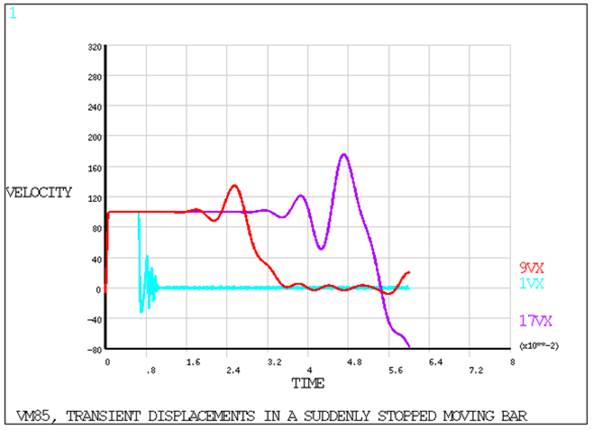VM85
VM85
Transient Displacements in a Suddenly Stopped Moving Bar
Overview
| Reference: | S. Timoshenko, D. H. Young, Vibration Problems in Engineering, 3rd Edition, D. Van Nostrand Co., Inc., New York, NY, 1955, pg. 305, problem 3. | ||
| Analysis Type(s): | Mode-Superposition Transient Dynamic Analysis (ANTYPE = 4) | ||
| Element Type(s): |
| ||
| Input Listing: | vm85.dat |
Test Case
A steel bar moving along the X-axis with a constant velocity vo is
suddenly stopped at the end X = 0. Determine the displacement at the free end and the axial stress σx near the
stopped end of the bar at time
, where a is the speed of sound in the bar.
| Material Properties | Geometric Properties | Loading | ||||||
|---|---|---|---|---|---|---|---|---|
|
|
|
Analysis Assumptions and Modeling Notes
The speed of sound in the bar is = 202,721 in/sec, hence time
= 0.0493288 sec. A static solution is done at the first load step. The final
time of 0.06 sec allows the bar to impact (at to = 0.0064 sec) and reach
its maximum deflection (at t = to + t1). The gap
stiffness (k = 30,000,000 lb/in) is arbitrarily selected high enough to minimize the elastic
contact deformation but low enough to also allow a practical integration time step size.
The integration time step size (ITS = 0.0001 sec) is based on the shortest period (during contact) to allow the abrupt changes in acceleration to be followed reasonably well, and to produce sufficient printout for the theoretical comparison.
The initial velocity is produced by a force = 1,825,000 lb acting over 4 ITS. The force is
halved at the first and last node (nodes 1 and 17) since these nodes are only attached to one
element instead of two elements like the other nodes. A "coasting" period of 60 ITS is
allowed before the gap (so = 0.64 in) closes at impact. An expansion pass
is done at t = to + t1 to obtain the stress
solution. POST26 is used to get the displacement solution and displays versus time.
Results Comparison
| Target[1] | Mechanical APDL [2] | Ratio | ||
|---|---|---|---|---|
| Mode-Superposition Transient Dynamic | d, in (t = 0.05573 sec) | 4.9329 | - | - |
| d, in (t = 0.0544 sec) | - | 4.7733 | 0.968 | |
| d, in (t = 0.0557 sec) | - | 4.7474 | 0.962 | |
| Expansion Pass | stressx , psi (t = 0.05573 sec) | 14799. | - | - |
| stressx , psi (t = 0.0557 sec) | - | 14819 | 1.001 | |
t is time before contact (0.0064 sec) included.
d is relative displacement between the ends of the bar.




